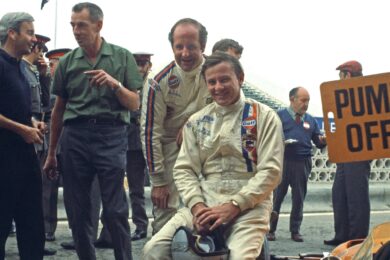David Hobbs and Jochen Mass, too, deserve mention. Hobbs, a versatile racer blessed with a neat turn of speed and a wicked wit, had a couple of outings in an M23, while the young and quietly determined Mass – who would become a McLaren fixture in 1975, 1976, and 1977 – also chipped in when called upon. Together, that intrepid quintet stitched together a campaign of cunning and cohesion: no fireworks, no crushing domination, just the steady accumulation of world championship points.
Yet it was a season not without drama. The world championship battles ebbed and flowed. Ferrari had re-emerged with a vengeance under the wily stewardship of Luca di Montezemolo, the impressive driving of the latest wunderkind, Niki Lauda, and the sometimes thuggish but often rapid wheelmanship of that veteran darling of the tifosi enjoying his best ever season in F1, Clay Regazzoni; Tyrrell had the fast and ambitious Jody Scheckter and the gifted and incautious Patrick Depailler; and Brabham, resurgent under Bernie Ecclestone’s ownership, had Carlos Reutemann blazing away in the beautiful and superfast BT44, supported first by Richard Roberts, then by Ricky von Opel, then by Teddy Pilette, and finally by Carlos Pace. But in the end it came down to the last race of the season, at Watkins Glen: Fittipaldi versus Regazzoni for the F1 drivers’ world championship, plus Scheckter with an outside chance; and McLaren versus Ferrari for the constructors’.
And, when the time came, the McLaren lads showed their mettle. The Brabhams were in a class of their own at the Glen, Reutemann scoring his third win of the season, having started from the pole and having led every lap; Pace finished second, 10.735sec behind his team leader. James Hunt was a distant third for Hesketh. Fittipaldi tucked a photo of his baby daughter into his overalls as he climbed into his McLaren — “for luck” — then he raced with precision and restraint, passing Regazzoni into Turn 1 (aka ‘the 90’) on lap one and, reminding himself that he needed only to finish ahead of the Ferrari man to become world champion, he then carefully stroked his McLaren to an unspectacular fourth place, knowing that that would be enough. After the race he said: “Now I know, for sure, that I’m certainly with the best team in F1. Perhaps the car isn’t the best, not the very best anyway, but the team is absolutely fantastic.”
So it was. Nonetheless, I often wonder how things might have panned out had Bruce not bought the farm, to resurrect the commonest euphemism of the time. Might he have been driving an M23 alongside Fittipaldi? After all, he was a year younger than Hulme. Would he have raced better than Denny did, thereby robbing Emerson of points and allowing Regazzoni to become F1 world champion for Ferrari? Might he even have become 1974 F1 world champion himself? We will never know. What we do know is that he was a racer from head to toe, from helmet to boots, and also a man of rare depth: philosophical, poetic even. “To do something well is so worthwhile,” he wrote when his 26-year-old friend and team-mate Timmy Mayer (Teddy’s little brother) had been killed in practice for a Tasman Series race at Longford, Tasmania, in 1964, “that to die trying to do it better cannot be foolhardy. It would be a waste of life to do nothing with one’s ability, for I feel that life is measured in achievement, not in years alone.”
Those words – etched for ever into the consciousness of everyone who truly loves our sport – rang truest of all in 1970, when we realised that Bruce had unwittingly written his own epitaph six years before his own death. But they also rang true in 1974, because the first F1 constructors’ world championship won by the team that Bruce had built was not only a sporting achievement but also a tribute: a tribute to the man who had dared to found a team in his own name then race its cars against the best in the world; a tribute to his friends and colleagues who continued to carry his flame through the dark time immediately after his shocking demise; and a tribute to the racers who finally brought it home.

The moment McLaren clinched the 2025 constructors’ title in Singapore
McLaren
And, now, 51 years later, in a week in which yet more F1 silverware sits gleaming in McLaren’s enormous trophy cabinet, the repeat performance feels very satisfying for people like me who once worked for the team. In 1974 there was Fittipaldi, Hulme, Hailwood, Hobbs, and Mass; in 2025 there is Norris and Piastri. We can trace the McLaren success story from Bruce’s humble workshops, first in Feltham then in Colnbrook, to the architectural cathedral of racing technology in Woking that Ron Dennis invited Queen Elizabeth II to open in 2004; from drawings inked on graph paper to CAD/CAM programmes running at teraflop speeds; from the down-to-earth idealism of Bruce and his boys to the multi-million-dollar cast-of-thousands mega-organisation run by Zak Brown and Andrea Stella.
Is it a better team nowadays? Well, it is certainly bigger – and, yes, it would be sentimental and perhaps even churlish to refuse to concede that it is also better. The world turns. Progress is inevitable. Things improve. But McLaren’s first F1 constructors’ world championship triumph should be venerated always – not only because Mayer, Coppuck, Caldwell, Alexander, and co built a good car and ran it well; and not only because they had a brilliant driver in Fittipaldi; but also because, in a crucible of grief and adversity, they refused to falter. Instead they honoured the man who had started it all, not with platitudes or sentiment, not with thoughts and prayers, but with victory; and that, when all’s said and done, is and I hope will always be the McLaren way.






